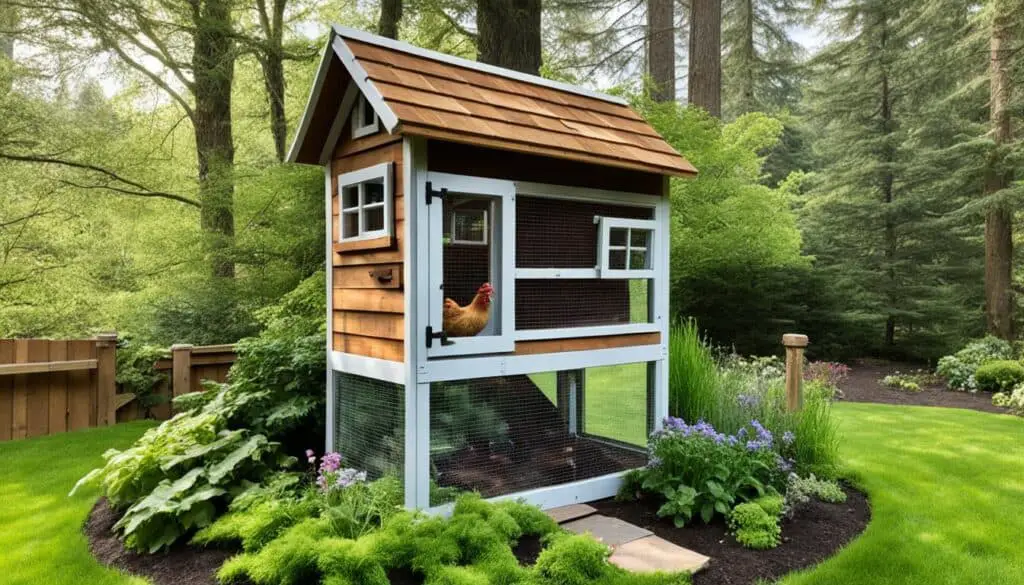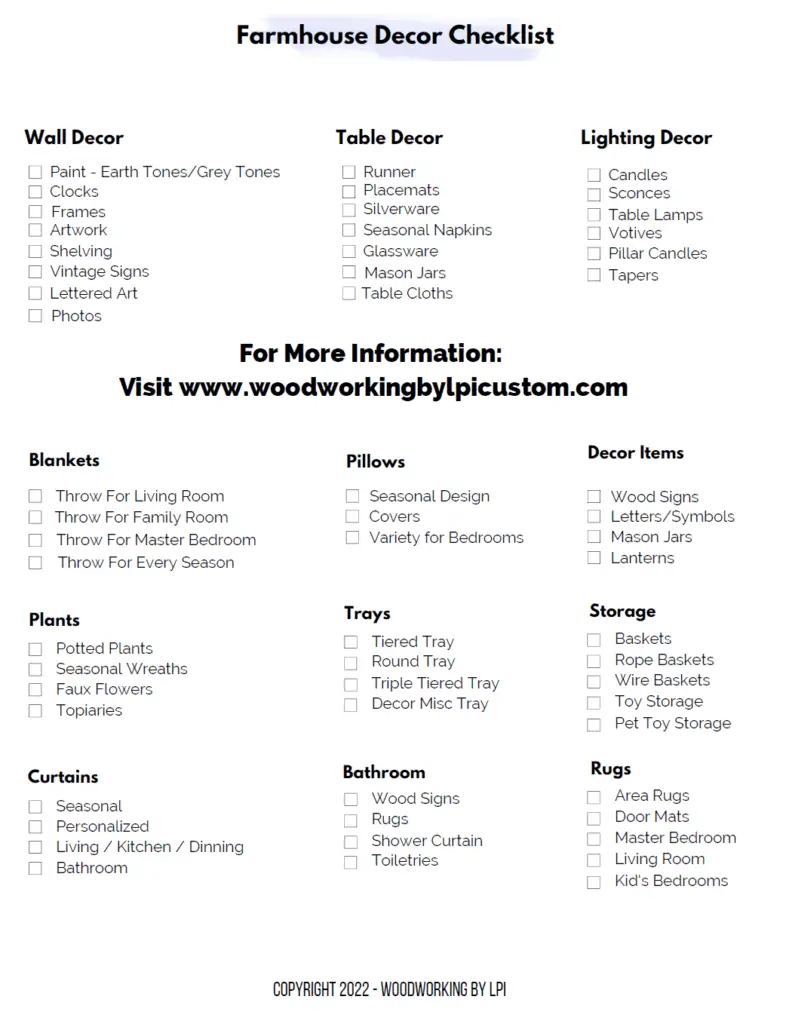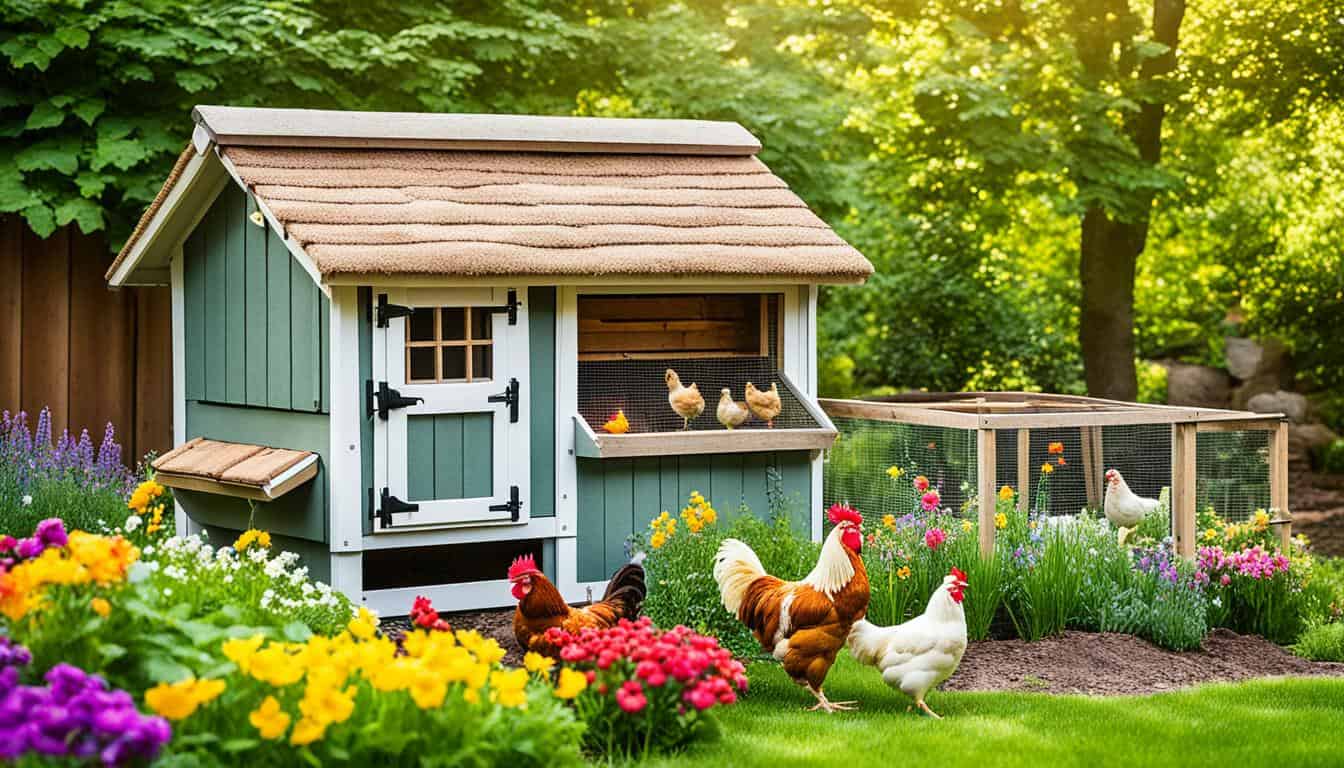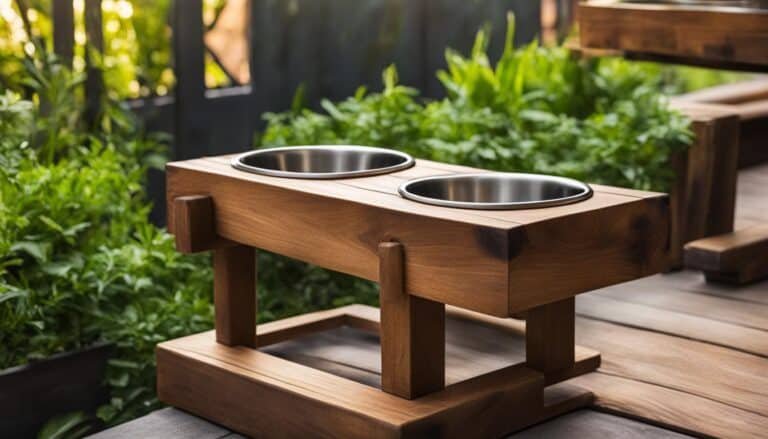Are you ready to embark on a DIY project that will not only enhance your backyard but also benefit your flock of feathered friends? Building your own chicken coop is a fulfilling endeavor that allows you to design a comfortable and secure home for your chickens. But where do you start? What are some fresh and innovative ideas that can inspire your chicken coop design?
- Building your own chicken coop allows you to customize the design to meet your specific needs and preferences.
- Designing a functional chicken coop involves considering factors such as ventilation, access to natural light, and protection from predators.
- Creative and unique designs can add flair to your backyard while providing a comfortable space for your chickens.
- Innovative features, such as automatic doors and timed lighting systems, can make daily maintenance tasks easier and more efficient.
- A safe and secure chicken coop is crucial to protect your flock from predators, while a comfortable environment promotes their health and well-being.
Benefits of Building Your Own Chicken Coop
Building your own chicken coop offers several advantages. First and foremost, it allows you to customize the design to fit your specific needs and preferences. You can create a coop that is the perfect size for your flock, with features that promote their comfort and well-being.
Additionally, building your own coop can be a cost-effective option compared to purchasing a pre-built one. By using readily available materials and your DIY skills, you can save money and allocate your budget towards other aspects of chicken care.
Moreover, constructing your own chicken coop gives you a sense of pride and satisfaction. It’s a hands-on project that allows you to showcase your creativity and craftsmanship. You’ll feel accomplished knowing that you’ve created a safe and functional home for your chickens.
With a DIY chicken coop, you have complete control over its design and layout. You can incorporate features such as nesting boxes, roosting bars, and ventilation systems that are tailored to your flock’s needs. This ensures that the coop provides a comfortable and conducive environment for your chickens to thrive.
When building your own chicken coop, you can also implement sustainable practices. By choosing eco-friendly materials and utilizing renewable energy sources, such as solar panels, you can reduce your environmental impact and create a more sustainable backyard setup.
Building your own chicken coop is a rewarding endeavor that empowers you to provide a safe and functional space for your flock. Not only does it offer customization options and cost savings, but it also allows you to create a unique and aesthetically pleasing addition to your backyard. Get started on your DIY chicken coop project and enjoy the benefits of raising happy and healthy chickens in your own backyard sanctuary.
Important Considerations Before Building a Chicken Coop
Before you start building your chicken coop, there are a few important considerations to keep in mind. Planning ahead and taking the time to address these factors will ensure that your coop is a safe and functional space for your chickens.
Comply with Local Regulations
Check your local ordinances to ensure that you comply with any regulations regarding backyard chicken coops. Familiarize yourself with any restrictions on flock size, setback requirements, or noise regulations. Adhering to these guidelines will help you avoid any legal issues and ensure a harmonious relationship with your neighbors.
Designing the Perfect Layout
When determining the layout of your chicken coop, consider your backyard space and the needs of your flock. A well-designed layout not only maximizes space but also enhances the overall functionality and convenience of the coop.
Here are a few key factors to consider when planning the layout:
- Ventilation: Ensure proper airflow by incorporating windows, vents, or louvered openings in the coop design. This helps maintain good air quality and prevents the buildup of moisture and odor.
- Natural Light: Providing access to natural light not only creates a more pleasant environment for your chickens but also boosts their overall health and productivity. Consider incorporating windows or skylights into the coop design to let in ample sunlight.
- Predator Protection: Design the coop with predator-proofing in mind. Use sturdy materials, secure doors, and wire mesh or hardware cloth to keep your flock safe from potential threats.
Accessibility and Maintenance
Make sure your chicken coop is easily accessible for cleaning, feeding, and egg collection. Consider including features such as removable trays for easy cleaning, external nest boxes for convenient access to eggs, and hinged doors for straightforward maintenance.
“A well-designed chicken coop layout ensures optimal functionality and convenience, making it easier to care for your flock and maintain a clean and healthy environment for your chickens.”
By carefully planning the layout of your chicken coop, you’ll create a space that promotes the well-being of your chickens and simplifies your daily tasks.
Design Ideas for a Functional Chicken Coop
When it comes to designing a functional chicken coop, there are many options to consider. You can choose from various layouts, such as a traditional rectangular coop or a multi-level design. Incorporating features like nesting boxes, roosting bars, and easy-access doors can make daily maintenance tasks, like collecting eggs and cleaning, a breeze. Additionally, consider the size of your coop based on the number of chickens you have and whether they will have access to a free-range area.
One popular design option for functional chicken coops is the rectangular layout. This classic design provides simplicity and ease of construction. The rectangular shape allows for efficient use of materials and provides ample space for your chickens to move around. It also makes it easier to clean and maintain the coop.
Another design idea is a multi-level chicken coop. This design maximizes vertical space and provides different levels for your chickens to explore and roost. A multi-level coop can be particularly beneficial if you have limited space in your backyard. It allows you to utilize the vertical space more efficiently and provides additional room for your flock.
Incorporating specific features into your chicken coop can greatly enhance its functionality. Nesting boxes are essential for your hens to lay their eggs comfortably. Make sure to provide one nesting box for every 3-4 chickens, and ensure easy access for egg collection. Roosting bars are also important for your chickens to perch and sleep comfortably. Install them at different heights to accommodate the size and preferences of your flock.
Easy-access doors are another feature to consider. Having doors that open wide or slide easily makes it convenient for daily tasks like cleaning the coop and collecting eggs. This saves you time and effort. You can also install a ramp for easy access between different levels or to the outdoor run.
When determining the size of your coop, consider the number of chickens you will have and whether they will have access to a free-range area. Providing enough space for your chickens ensures their comfort and well-being. Chickens that have access to a free-range area will require less space inside the coop, but it’s still important to provide enough room for roosting, nesting, and moving around.
Here is an example of a functional chicken coop design:
| Feature | Description |
|---|---|
| Nesting Boxes | Provide 1 nesting box per 3-4 chickens |
| Roosting Bars | Install at different heights for chickens to perch and sleep |
| Easy-Access Doors | Wide or sliding doors for easy cleaning and egg collection |
| Size | Based on the number of chickens and access to a free-range area |
By incorporating these design ideas into your chicken coop, you can create a functional and efficient space for your feathered friends.
Creative and Unique Chicken Coop Designs
If you’re looking to add some flair to your backyard, consider incorporating creative and unique designs into your chicken coop. With a little imagination, you can make your coop a standout focal point in your outdoor space.
One option is to create a themed coop that resembles a quaint farmhouse or a charming cottage. This not only adds visual interest but also gives your coop a touch of personality. You can use rustic materials like weathered wood and vintage-inspired accents to enhance the farmhouse aesthetic. For a cottage-style coop, consider adding window boxes filled with colorful flowers to create a whimsical and inviting look.

Another creative idea is to repurpose existing structures like old sheds or playhouses to serve as your chicken coop. This not only adds a unique touch to your backyard but also reduces the cost and effort of building from scratch. You can convert a shed into a spacious and functional coop by adding windows for ventilation, nesting boxes, and a secure door. A playhouse can be transformed into a charming coop with a fresh coat of paint, decorative trim, and child-friendly details.
Don’t be afraid to get creative with the materials and colors you use for your chicken coop. By using vibrant paint colors, decorative details, and even upcycled materials, you can create a coop that is not only functional but also a stylish addition to your outdoor space.
Summary:
To make your backyard truly unique, consider incorporating creative and unique designs into your chicken coop. Whether it’s a themed coop, a repurposed structure, or creative use of materials and colors, there are countless ways to make your coop stand out. Let your imagination soar and create a chicken coop that showcases your personal style while providing a safe and comfortable home for your flock.
Innovative Features for a Modern Chicken Coop
For those who love technology and modern conveniences, there are innovative features you can incorporate into your chicken coop. With these advancements, you can enhance the functionality and efficiency of your coop, providing your chickens with a state-of-the-art home.
One innovative feature to consider is an automatic door. This convenient addition allows your chickens to have easy access to the coop during the day while keeping them safe from predators at night. With programmable timers, you can set specific opening and closing times to align with your chickens’ natural routines.
Another useful feature is a timed lighting system. By simulating natural daylight patterns, you can regulate your chickens’ internal clocks, which can positively affect their egg production. This feature is especially beneficial in areas with shorter daylight hours or where winters are harsh.
Research has shown that extending light exposure for backyard hens can lead to increased egg production. By incorporating a timed lighting system into your chicken coop, you can help stimulate egg-laying and ensure a steady supply of fresh eggs throughout the year.
– Dr. Jennifer Martin, Poultry Expert
If you’re concerned about the security of your coop, consider installing security cameras. These cameras provide real-time surveillance, allowing you to monitor your chickens even when you’re not physically present. They can help you identify any potential risks or issues and provide a sense of peace knowing that you can keep an eye on your flock at all times.
Additionally, sustainable features are gaining popularity in chicken coop design. Consider integrating a living roof, which consists of vegetation on top of the coop, providing insulation and reducing heat absorption. This eco-friendly feature not only helps regulate the coop’s temperature but also adds an aesthetic appeal to your backyard.
Another sustainable option is incorporating solar panels into your coop’s design. Solar panels can provide electricity to power your coop’s lighting, automatic doors, and even charging stations for electronic devices. By harnessing renewable energy, you can reduce your environmental impact and enjoy the benefits of a self-sufficient coop.
Comparison Table: Innovative Features for a Modern Chicken Coop
| Feature | Description | Benefits |
|---|---|---|
| Automatic Door | An automated door that opens and closes based on programmable timers. |
|
| Timed Lighting System | A lighting system that replicates natural daylight patterns. |
|
| Security Cameras | Surveillance cameras to monitor the coop and chickens remotely. |
|
| Living Roof | A vegetation-covered roof that provides insulation and reduces heat absorption. |
|
| Solar Panels | Photovoltaic panels that generate electricity from sunlight. |
|
Tips for Ensuring Safety and Security in Your Chicken Coop
Safety and security should be your top priorities when designing your chicken coop. By implementing the right measures, you can protect your feathered friends from predators and ensure their well-being. Here are some essential tips:
1. Build a Sturdy and Predator-Proof Coop
Constructing a strong and durable chicken coop is crucial in safeguarding your flock. Use high-quality materials that can withstand weather conditions and the occasional pecking or scratching from your chickens. Reinforce the structure with sturdy hardware, such as heavy-duty hinges and latches, to prevent predators from gaining access.
2. Secure Doors and Windows
Make sure all doors and windows in your chicken coop are secure and properly sealed. Install locks or latches that are resistant to tampering. Inspect the coop regularly for any wear or damage and promptly address any issues to maintain the security of the coop.
3. Use Hardware Cloth or Wire Mesh
Cover any openings or ventilation areas with hardware cloth or wire mesh to create a barrier against predators. Ensure that the mesh has small enough openings to prevent entry by snakes, rats, or other small animals that may harm your chickens.
4. Consider an Automatic Door
An automatic door can be a valuable addition to your chicken coop, providing an extra layer of security. These doors can be programmed to open and close at specific times, allowing your chickens to roam freely during the day and automatically closing at night to keep them safe from nocturnal predators.
| Preventive Measures | Description |
|---|---|
| Sturdy Coop Construction | Use strong materials and reinforced hardware to build a predator-proof chicken coop. |
| Secure Doors and Windows | Install secure locks and regularly inspect doors and windows for any vulnerabilities. |
| Hardware Cloth or Wire Mesh | Cover openings with mesh material that prevents predators from entering the coop. |
| Automatic Door | Add an automatic door that opens and closes at specific times to protect your chickens. |
5. Implement a Secure Latch System
Consider using a secure latch system to ensure that the coop remains tightly closed. Predators like raccoons and foxes can be very skilled at tampering with traditional latches, so using a more advanced locking mechanism will provide extra protection.
To summarize, when designing your chicken coop, prioritize safety and security. Build a sturdy and predator-proof structure, secure all doors and windows, cover openings with hardware cloth or wire mesh, and consider advanced features like automatic doors and secure latch systems. By implementing these measures, you can create a safe and secure haven for your feathered flock.
Next, we’ll explore the importance of creating a comfortable environment for your chickens. A cozy and inviting coop not only enhances their well-being but also contributes to optimal egg production. Let’s uncover the secrets to a comfortable chicken coop in the next section.
Creating a Comfortable Environment for Your Chickens
A comfortable and conducive environment is crucial for the health and well-being of your backyard chickens. By providing them ample space to move around and stretch their wings, both inside the coop and in the outdoor run, you can ensure their physical and mental well-being. Proper ventilation and insulation are essential to regulate temperature and prevent excessive moisture buildup that can lead to respiratory issues. To create a cozy and inviting atmosphere, consider using natural materials like straw or wood shavings for bedding and nesting boxes.
Allowing your chickens sufficient space to roam not only promotes their mobility but also reduces stress. When designing your chicken coop, consider the size of your flock and provide enough area for them to move comfortably. Access to an outdoor run is beneficial as it allows for fresh air, sunlight, and natural foraging, which helps keep them mentally stimulated and physically active.
Proper ventilation is key to maintaining a healthy environment within the coop. It ensures a constant supply of fresh air while preventing the build-up of ammonia and excessive moisture, which can lead to respiratory issues and mold growth. Incorporate windows or vents in your chicken coop design to allow for adequate airflow. Make sure to position them strategically to avoid direct drafts that may cause discomfort to your chickens.
Essential Elements for a Comfortable Chicken Coop:
- Ample space for movement and stretching wings
- Proper ventilation and insulation
- Access to an outdoor run for fresh air and foraging
- Natural bedding materials like straw or wood shavings
Creating a comfortable environment for your chickens not only enhances their overall well-being but also contributes to better egg production and overall flock health. By prioritizing their comfort, you can ensure that your backyard chickens lead happy and healthy lives.
Maximizing Egg Production with Thoughtful Coop Design
If you’re primarily raising chickens for their eggs, a well-designed chicken coop can play a crucial role in maximizing egg production. By creating a comfortable and efficient environment for your hens, you can encourage consistent egg-laying and ensure easy access to the precious harvest. Here are some tips for thoughtful coop design that can help you make the most of your flock’s egg-laying potential.
Incorporate Ample Nesting Boxes
When designing your chicken coop, it’s essential to incorporate enough nesting boxes for your flock. A general rule of thumb is to provide one nesting box for every 3-4 chickens. Having sufficient nesting boxes ensures that all your hens have a private and comfortable space to lay their eggs without feeling crowded or stressed.
Ensuring Easy Access
Easy access to the nesting boxes is another important consideration. Make sure the boxes are easily accessible for egg collection, allowing you to retrieve the eggs without disturbing the hens or causing them unnecessary stress. Conveniently positioned, well-designed access points will save you time and effort during egg collection.
Creating a Clean and Comfortable Environment
A clean and comfortable coop environment is crucial for your hens’ well-being and consistent egg production. Regularly cleaning the coop, removing any soiled bedding or debris, and providing fresh nesting materials will help create a clean and inviting space for your chickens to lay their eggs. A comfortable environment with proper ventilation, cozy bedding, and appropriate lighting will encourage your hens to lay eggs regularly and comfortably.
Optimizing Lighting
Proper lighting plays a vital role in regulating your hens’ egg-laying cycle. Ensure that your coop has adequate natural or artificial light to simulate the natural day-night rhythm. This helps maintain a consistent egg production schedule throughout the year. Additionally, consider installing timers or automatic lighting systems to ensure a consistent and reliable light source for your flock.
Providing a Stress-Free Environment
Reducing stress levels among your hens is essential for optimal egg production. Avoid overcrowding your coop and provide ample space for your chickens to move around comfortably. Incorporate enrichment activities and perches to keep them engaged and active. A stress-free environment will help your hens produce eggs consistently and maintain their overall health.

Creating a thoughtful coop design can significantly impact your flock’s egg production and overall well-being. By implementing these tips and considerations, you can enhance your chickens’ laying capabilities and enjoy a bountiful supply of fresh eggs from your backyard coop.
| Benefit | Description |
|---|---|
| Increase Egg Production | A well-designed coop helps create a conducive environment for consistent egg-laying. |
| Easier Egg Collection | Thoughtful coop design ensures easy access to nesting boxes, simplifying egg collection. |
| Improved Hen Comfort | A clean and comfortable coop environment promotes a stress-free laying experience for hens. |
| Optimized Lighting | Proper lighting schedules stimulate the natural egg-laying cycle. |
| Reduced Stress Levels | A spacious and enriching coop minimizes stress among chickens, leading to more consistent egg production. |
Enhancing Aesthetics with Stylish Chicken Coop Designs
Your chicken coop doesn’t have to be just functional; it can also be a visually appealing addition to your backyard. By incorporating stylish elements and unique chicken coop ideas into your design, you can create a coop that not only provides a safe and comfortable space for your chickens but also enhances the overall aesthetic of your outdoor area.
Consider these creative and innovative ways to enhance the aesthetics of your chicken coop:
- Add decorative trim or molding to give your coop a polished and sophisticated look.
- Install window boxes filled with colorful flowers to bring life and vibrancy to the exterior of your coop.
- Choose a charming paint color scheme that complements the surroundings and adds personality to your coop.
- Create a custom sign or plaque with your coop’s name or a whimsical phrase to add a personal touch.
- Use landscaping elements such as potted plants or a small garden near the coop to create a cohesive and inviting outdoor space.
Remember to ensure that the design elements you incorporate into your chicken coop align with the needs of your flock. Avoid any features that could pose a danger to the chickens or compromise the functionality of the coop.
With your creativity and attention to detail, you can transform your chicken coop into an eye-catching and stylish structure that adds beauty and charm to your backyard.
Budget-Friendly DIY Chicken Coop Ideas
Building a chicken coop doesn’t have to break the bank. With some creativity and resourcefulness, you can create a functional and attractive coop without a hefty price tag. Here are some budget-friendly DIY chicken coop ideas that utilize cost-effective materials and repurposed items.
1. Salvaged Wood Construction
Consider using salvaged wood for constructing your chicken coop. Look for discarded pallets, old fences, or unused lumber that can be repurposed. Salvaged wood not only reduces costs but also adds a rustic and charming aesthetic to your coop design.
2. Recycled Materials
Look for creative ways to incorporate recycled materials into your chicken coop. For example, use old windows as coop doors or repurpose an old bathtub as a dust bath for your chickens. Recycling not only saves money but also reduces waste and promotes sustainability.
3. Repurposed Structures
If you have an existing structure like a shed or playhouse that is no longer in use, consider repurposing it into a chicken coop. With some modifications and additions like nesting boxes and roosting bars, you can transform an unused structure into a functional and cost-effective chicken coop.
4. Simple Design
Opt for a simple and minimalist design for your chicken coop. This not only reduces construction costs but also makes it easier to maintain and clean. A straightforward design with basic features like a secure door, adequate ventilation, and predator-proofing can still provide a comfortable and safe space for your chickens.
“Building a chicken coop on a budget doesn’t mean compromising on quality. By getting creative with materials and repurposing items, you can create a coop that meets both your needs and your budget.”
5. DIY Feeder and Waterer
Skip the expensive store-bought feeders and waterers and create your own DIY versions. Use simple materials like buckets, PVC pipes, or repurposed containers to make functional and cost-effective feeding and watering stations for your chickens.
6. Efficient Space Utilization
Maximize space utilization by incorporating vertical elements in your chicken coop design. Use wall-mounted nesting boxes or build multi-level roosting areas to make the most of the available space. This allows you to accommodate more chickens within a smaller footprint.
7. Upcycled Accessories
Add a touch of creativity and personality to your chicken coop by upcycling accessories. Use old tires as dust-bathing areas, repurpose tin cans as hanging planters, or transform an old ladder into a ladder-style chicken roost. These unique touches not only add visual interest but also save money on purchasing new accessories.
8. The DIY Approach
Embrace the do-it-yourself ethos by taking on various aspects of coop construction yourself. Whether it’s framing, painting, or installing hardware, tackling these tasks on your own can significantly reduce labor costs and give you a sense of accomplishment.
By employing these budget-friendly DIY chicken coop ideas, you can save money while still creating a functional and attractive home for your feathered friends.
Maintenance and Care Tips for Your Chicken Coop
Proper maintenance and care are essential for the longevity and functionality of your chicken coop. By following these tips, you can ensure a safe and comfortable environment for your backyard chickens.
Regular Cleaning
To keep your chicken coop clean and free from harmful bacteria, it’s important to establish a regular cleaning routine. Remove droppings and soiled bedding from the coop and nesting boxes on a weekly basis. This will help prevent the buildup of ammonia and reduce the risk of respiratory issues for your chickens.
Bedding and Nesting Materials
Replace bedding and nesting materials as needed to maintain a clean and comfortable living space for your chickens. Using materials like straw or wood shavings can provide insulation and absorb moisture effectively. Regularly check for signs of mold or mildew, and remove any affected bedding immediately to prevent health issues.
Inspect for Wear and Tear
Regularly inspect your chicken coop for any signs of wear and tear. Check for loose or damaged wires, nails, or hinges that may pose a safety risk to your chickens. Repair or replace any damaged parts promptly to ensure the coop remains secure and predator-proof.
Provide Proper Ventilation
Adequate ventilation is crucial for maintaining good air quality inside the chicken coop. Ensure that windows or vents are properly placed to allow for fresh airflow. This will help prevent the buildup of moisture, ammonia, and odors, keeping your chickens healthy and comfortable.
Secure Doors and Entry Points
Regularly check that all doors, windows, and entry points in your chicken coop are secure. Predators such as raccoons, foxes, and rats can pose a threat to your flock. Use sturdy latches and hardware cloth to reinforce any vulnerable areas and prevent unauthorized access.
Recommended Maintenance Tasks for Your Chicken Coop
| Task | Frequency |
|---|---|
| Cleaning droppings and soiled bedding | Weekly |
| Replacing bedding and nesting materials | As needed |
| Inspecting for wear and tear | Monthly |
| Checking ventilation and airflow | Monthly |
| Securing doors and entry points | Ongoing |
By following these maintenance and care tips, you can ensure that your chicken coop provides a safe and comfortable habitat for your backyard flock. Taking the time to properly care for your coop will contribute to the overall health and well-being of your chickens, allowing them to thrive in their home.
Conclusion
Building your own chicken coop is an exciting project that allows you to create a personalized and functional space for your backyard flock. By incorporating fresh and innovative chicken coop ideas, you can provide your chickens with a safe, comfortable, and stylish home. Whether you’re an experienced DIY enthusiast or a beginner, there are options available for every skill level and budget.
Start planning your chicken coop project today! Consider the layout, design, and features that will best suit the needs of your flock. You can choose from a variety of creative and unique designs, or opt for a more modern and technologically advanced coop with innovative features. Remember to prioritize safety and security, ensuring your coop is predator-proof and easy to maintain.
By building your own chicken coop, you’ll not only save money compared to purchasing a pre-built one, but you’ll also experience a sense of pride and satisfaction in creating a home for your chickens. Take this opportunity to enhance the aesthetics of your backyard while providing a comfortable environment for your feathered friends.
So, what are you waiting for? Start your DIY chicken coop project today and enjoy the benefits of raising happy and healthy hens in your own backyard.
FAQ
What are the benefits of building your own chicken coop?
Building your own chicken coop allows you to customize the design to fit your specific needs and preferences. It can also be a cost-effective option compared to purchasing a pre-built coop and gives you a sense of pride and satisfaction.
What considerations should I keep in mind before building a chicken coop?
Before building a chicken coop, it’s important to check local ordinances for any regulations and consider factors such as ventilation, access to natural light, and protection from predators.
What design ideas are there for a functional chicken coop?
You can choose from various layouts, incorporate features like nesting boxes and roosting bars, and determine the size of your coop based on the number of chickens and whether they will have access to a free-range area.
What are some creative and unique chicken coop designs?
Creative and unique chicken coop designs can include themed coops that resemble farmhouses or repurposed structures like old sheds or playhouses. You can also get creative with materials and colors to make your coop stylish.
What innovative features can I incorporate into my chicken coop?
Innovative features for a modern chicken coop can include automatic doors, timed lighting systems, security cameras, and sustainable features like a living roof or solar panels.
How can I ensure safety and security in my chicken coop?
You should make sure the coop is sturdy and predator-proof with secure doors and windows. Using hardware cloth or wire mesh to cover openings and integrating an automatic door or secure latch system can also enhance safety and security.
How can I create a comfortable environment for my chickens?
Providing ample space for your chickens to move around, proper ventilation and insulation, and using natural materials like straw or wood shavings for bedding can help create a comfortable environment.
How can I maximize egg production with thoughtful coop design?
To maximize egg production, incorporate enough nesting boxes for your flock, ensure easy access for egg collection, provide a clean and comfortable environment for egg laying, and create a stress-free environment with proper lighting.
How can I enhance aesthetics with stylish chicken coop designs?
You can enhance aesthetics by incorporating elements like decorative trim, window boxes with flowers, or a charming paint color scheme that complements the overall aesthetic of your outdoor space.
What are some budget-friendly DIY chicken coop ideas?
Budget-friendly DIY chicken coop ideas include using salvaged wood or recycled materials, repurposing existing structures like sheds or playhouses, and getting creative with resourcefulness.
What maintenance and care tips should I follow for my chicken coop?
Regularly clean the coop, replace bedding and nesting materials as needed, inspect for wear and tear, and make necessary repairs to ensure the coop remains safe and secure.












